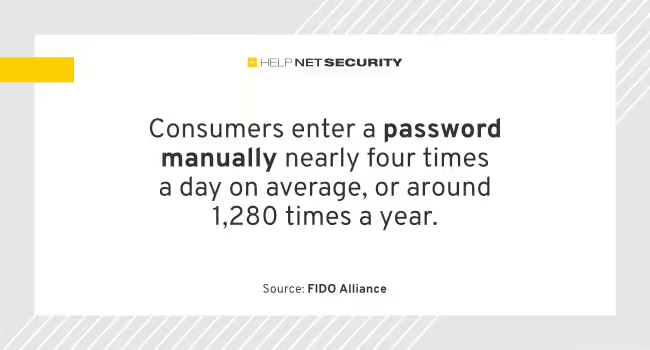Legacy authentication leads to growing consumer frustration – Help Net Security
Despite widespread usage of passwords lingering on, consumers want to use stronger, more user-friendly alternatives, according to FIDO Alliance.

Entering a password manually without any form of additional authentication was the most commonly used authentication method across the use cases tracked – including accessing work computers and accounts (37%), streaming services (25%), social media (26%), and smart home devices (17%).
Consumers have limited password alternatives
Consumers manually enter a password nearly four times daily, or around 1,280 times yearly. The only exceptional scenario to this trend was financial services, where biometrics (33%) narrowly beat passwords (31%) as the most used sign-in method.
This is especially interesting considering biometrics’ rising popularity as an authentication method. When asked what authentication method people consider most secure and the method they prefer, biometrics ranked as the favorite in both categories, rising around 5% in popularity since last year. This suggests consumers want to use biometrics more but don’t have the opportunity.
“This year’s Barometer data showed promising signs of shifting consumer attitudes and desire to use stronger authentication methods, with biometrics especially proving popular. That said, high password usage without 2FA worryingly reflects how little consumers are still being offered alternatives like biometrics, resulting in lingering usage,” commented Andrew Shikiar, Executive Director and CMO of the FIDO Alliance.
Scams are getting more sophisticated
54% of people have noticed an increase in suspicious messages and scams online, while 52% believe these have become more sophisticated.
Threats are seen to be active across several channels, but primarily email, SMS messages, social media, and fake phone or voicemails. The increased accessibility of generative AI tools is a likely driver of this rise in scams and phishing threats.
Tools like FraudGPT and WormGPT, which have been created and shared on the dark web explicitly for use in cybercrime, have made crafting compelling social engineering attacks far simpler, more sophisticated, and easier to do at scale. Deepfake voice and video are also being used to bolster social engineering attacks, tricking people into thinking they are talking to a known trusted person.
Shikiar added: “Phishing is still by far the most used and effective cyberattack technique, which means passwords are vulnerable regardless of complexity. With highly accessible generative AI tools now offering bad actors the means to make more convincing and scalable attacks, consumers and service providers must listen to consumers and start to look at non-phishable and frictionless solutions like passkeys and on-device biometrics more readily available, rather than iterating on ultimately flawed legacy authentication like passwords and OTPs.”
Passkeys, which provide secure and convenient passwordless sign-ins to online services, have grown in consumer awareness despite still being live just over a year, rising from 39% in 2022 to 52% awareness today.
Strong industry support for the non-phishable authentication
The non-phishable authentication method has been publicly backed by many big players in the industry – Google recently announced that passkeys are now available for all its users to move away from passwords and two-step verification, as has Apple, with other brands like PayPal also making these available to consumers in the last twelve months.
The negative impact caused by legacy user authentication was also revealed to be getting worse. 59% of people have given up accessing an online service and 43% have abandoned a purchase in the last 60 days, with the frequency of these instances rising year on year to nearly four times per month, per person, up by around 15% on last year.
Poor online experiences are ultimately hitting businesses’ bottom lines and causing frustration among consumers.
70% of people have had to reset and recover passwords in the last two months because they’d forgotten them, further highlighting how inconvenient passwords are and their role as a primary barrier to a seamless online user experience.


